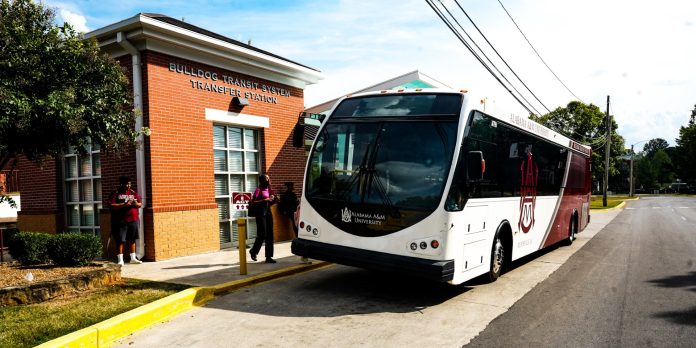HUNTSVILLE — Alabama A&M University’s Bulldog Transit System has been awarded an $8.1 million Competitive Low-No Emissions Program Federal Assistance grant. This funding will accelerate BTS’s ongoing efforts to achieve a fully zero-emissions transit system by 2031.
Since 2017, the BTS has been transitioning toward a sustainable, renewable energy future by phasing out fossil fuel buses and replacing them with battery-electric buses and related infrastructure. The grant will help fund major upgrades, including expanding the capacity of the solar power microgrid system to 2.5 megawatts for BTS’s electric storage system, which powers its charging stations and bus facilities.
“This funding allows us to expand on the infrastructure we’ve already built and to enhance our solar energy capabilities,” said BTS Director Marshall Chimwedzi. “Phase II will include adding chargers, a driver’s lounge, and microgrid monitoring rooms to the bus storage facility. We’ll also enclose the service bay and upgrade our information systems with real-time monitors.”

The project includes an eight-bay expansion to the bus storage station and workforce development programs to train technicians in solar and electric bus maintenance. BTS will also purchase a zero-emissions autonomous shuttle, an electric shuttle bus, and an electric service truck to further support operations. The grant is active through March 30, 2031, with a target of achieving 100% zero emissions by 2031.
In 2019, Alabama A&M became the first Historically Black College or University (HBCU) to introduce electric buses, along with a charging station and bus storage facility. The University received an additional $4.2 million grant in 2021 to purchase more electric buses, construct a bus service bay, and install a battery-electric storage system with charging stations.
“The University and surrounding communities will benefit from reduced harmful emissions, contributing to environmental justice,” Chimwedzi said. “This initiative will serve as a model for other transit agencies and aligns with the U.S. Department of Transportation’s sustainabillity goals.”
Don’t miss out! Subscribe to our email newsletter to have all our smart stories delivered to your inbox.



